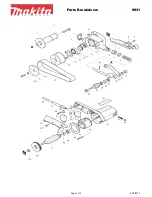
G1066/G1066Z/G1079 Drum Sander
-23-
Test Run
Once the assembly is complete and the adjust-
ments are done to your satisfaction, you are
ready to test the machine.
Turn on the power supply at the main panel.
Press the
START
button. Make sure that your fin-
ger is poised on the
STOP
button, just in case
there is a problem. The drum sander should run
smoothly, with little or no vibration or rubbing
noises. Strange or unnatural noises should be
investigated and corrected before operating the
machine further. To avoid injury or damage to the
machine,
DO NOT
attempt to make adjustments
to the machine without turning it off and unplug-
ging it from its power source.
If noises occur that cannot be found by visual
inspection, feel free to contact our Service
Department for help.
DO NOT attempt to investigate or adjust any
features of the machine while it is running.
Wait until the machine is turned off,
unplugged and all working parts have come
to a rest before you do anything! Failure to
do so could result in severe injury or dam-
age to equipment.
DO NOT sand more than one board at a time.
Minor variations in thickness can cause one
board to be propelled by the rapidly spin-
ning sanding drum and ejected from the
machine. NEVER stand directly in front of
the outfeed area of the machine. Failure to
do so could result in severe personal injury.
G1066/G1079
Your new Model G1066/G1079 Drum Sander is a
relatively simple piece of equipment to set up and
run. Under most sanding conditions, a normal cut
is no more than
1
⁄
64
". This depth can be achieved
by approximately
1
⁄
4
turn of the table height han-
dle. Attempts to remove too much can cause jam-
ming, wood burning, rapid paper wear or tearing,
poor finish and belt slippage. We recommend that
wide stock be sent through two to three times
without adjusting the table height. Turn the stock
180° to ensure an even cut. The following is the
correct start-up and operating procedure for
either of these machines.
1.
Start the dust collector.
2.
Make thickness adjustment. Place workpiece
on the conveyor table and turn the table han-
dle until the workpiece can be sanded and
fed through smoothly. Turning the handle
clockwise will raise the conveyor table.
Turning the table handle counter-clockwise
will lower the conveyor table.
3.
Remove the workpiece from the conveyor
belt.
4.
Start the Drum Sander and feed your stock.
Retrieve by standing at the side–not at the
outfeed end.
5.
Check the sanded piece. Is the piece
smooth? Mark a squiggly pencil line on a
board and sand it to test for even sanding.
Look for uniform removal of the line. If the
line is not removed uniformly, refer to the
adjustment section earlier in the instruction
manual.
NOTICE
We strongly recommend sending wide
stock through the sander two or three times
without adjusting the height. This is an
important method for preventing burning
your wood or ruining sandpaper.
Summary of Contents for G1066
Page 32: ... 30 G1066 G1066Z G1079 Drum Sander G1066 STAND TABLE ELEVATION ...
Page 33: ...G1066 G1066Z G1079 Drum Sander 31 G1066 FEED BELT TABLE ...
Page 34: ... 32 G1066 G1066Z G1079 Drum Sander G1066 DRUM ROLLER MECHANISM ...
Page 36: ... 34 G1066 G1066Z G1079 Drum Sander ...
Page 38: ... 36 G1066 G1066Z G1079 Drum Sander G1066Z ...
Page 39: ...G1066 G1066Z G1079 Drum Sander 37 G1066Z ...
Page 40: ... 38 G1066 G1066Z G1079 Drum Sander G1066Z ...
Page 43: ...G1066 G1066Z G1079 Drum Sander 41 ...
Page 45: ...G1066 G1066Z G1079 Drum Sander 43 G1079 STAND TABLE ELEVATION ...
Page 46: ... 44 G1066 G1066Z G1079 Drum Sander G1079 FEED BELT TABLE ...
Page 47: ...G1066 G1066Z G1079 Drum Sander 45 G1079 DRUM ROLLER MECHANISM ...
















































